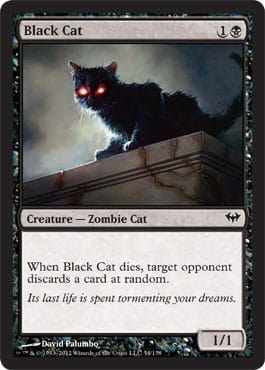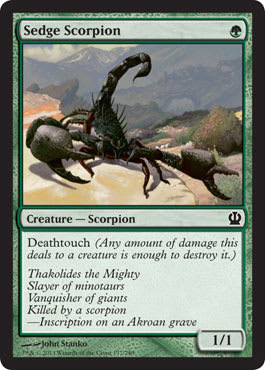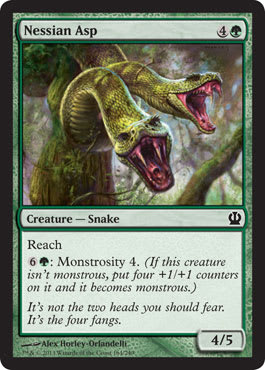Magic is a perpetual-motion machine. If scientists were able to harvest the energy generated by the progress of design, development, and knowledge of the game . . . well, one could say that cars really could run on Magic. One of the great leaps forward for design as it relates to Cube is the concept of lenticular cards. The potential unleashed by this discovery could launch a small object into space.
Mark Rosewater does a fantastic job explaining what a lenticular card is in the above-linked article. Named for the collectible cards that appear as different images when viewed from different angles, they are cards that fill multiple roles for different members of the player base. Rosewater uses Black Cat as an example: To a neophyte, it is simple a creature, but as a player’s skill increases, she or he will notice new things and new ways to use it (Zombie creature type, death trigger) that influences how the card is played. This is valuable because it allows cards to appeal to a wide variety of players while condensing the utility of multiple cards. Lenticular cards are the ultimate space-savers, packing more awesome into new sets.
Cube designers can make great use of this concept. While those who build Cubes may or may not be crafting their own cards, they are trying to create Draft environments in which each card has to matter. At the same time, they can be limited by some factor (all-commons Cubes, single copies of each card, or in some cases flavor), which means packing as much punch as possible into a limited card set. Applying the lenticular eye to the inclusions in any draftable stack can only increase the quality of Drafts. In my opinion, there are two ways to examine cards in this manner: stitchers and redundancy.
Stitchers are those cards that fill different roles in various decks. Sometimes key cards and sometimes role-players, these cards are necessary due to the singleton nature of many Cubes. Since there will be one copy of any given spell in a Cube, having cards that fill multiple roles are important. Take Wandering Wolf for example. It is nigh-impossible to make a Theros-style heroic deck work in a singleton Cube due to the mere number of creatures with the ability. Here, Wandering Wolf works just fine carrying a Bonesplitter or wearing a Hopeful Eidolon, and it finds a home in a Selesnya Voltron deck. At the same time, Wandering Wolf can act as a finisher in a Golgari deck that packs Shambling Shell or any deck that wants a 2-power creature on the second turn. Wandering Wolf is a card that means different things to different decks and shines because of this ability.
Similar to this, but of a different stripe, are cards that are included for redundancy. A more important concept in singleton Cubes, having a critical mass of a style of card is important to making certain strategies work. As I listed (but failed to really explain) in my article on Boros, that archetype requires a significant number of 2-drops to operate in an optimal fashion. This, in turn, means I have to keep my eyes peeled for new red and white 2-drops to help strengthen that guild as new sets release. Wingsteed Rider is one such card, as it fits very well into any old deck and has redundancy with cards such as Leonin Skyhunter and Burrenton Bombardier—it is just fine as a 2/2 flyer for 3 mana. In this case, it is just a creature, and yet, it becomes an all-star when it can be paired with a Rancor.
These concepts are inextricably linked and are two sides of the same coin—in my Cube, I want to have cards that can always be played but can also be a standout in the right card and make people say, “I want to draft that deck.” This, in turn, can lead to an increase in the repeat value of the Cube—sometimes, Wingsteed Rider will just be a Wind Drake, and other times, it will just dominate a game.
So, how does this apply to crafting a Cube? For my Cube, cards of this nature fit naturally into Golgari decks. Golgari is a Rock- or attrition-style deck in my Cube, with a focus on cards that interact with the graveyard. While the former descriptor allows for cards that are simply good, finding cards that are comfortable in burial plots and under the sun are exactly lenticular.
A good Golgari deck wants to exhaust an opponent’s resources. It does this with creatures that come with built-in card advantage and that have pronounced long-game effects. Golgari decks want to prioritize two-for-ones, as these are the best way to extract extra value from its deck. Golgari is also among the best decks for splashing and making use of the strong black and green gold cards in the Cube.
Survive – The first priority of Golgari is to make it to the late game. It is at this point when the guild’s inevitability can take over. This means taking strong blockers that can trade up, a la Sedge Scorpion and Typhoid Rats. Deadly Recluse is especially nice here, as it helps to stem the bleeding from an aerial assault. Theros Draft standout Baleful Eidolon is a newer addition that plays exceptionally well in a deck that can make as much use of expended resources as Golgari. Sakura-Tribe Elder and Sylvan Ranger are both solid speed bumps that can find additional lands, while Grim Roustabout and Butcher Ghoul can both absorb some hits. The creatures with deathtouch are a high priority since they can do wonders with Gravedigger and its brethren.
Advance – These are your bread-and-butter card-advantage creatures. All solid 2/2s for 3 mana that do something upon being summoned, these creatures do yeoman’s work in giving Golgari the cards it needs to win the grind. Phyrexian Rager and Chittering Rats are perfect examples, and green can mimic these in Borderland Ranger and CIvic Wayfinder. Yavimaya Elder might be the best of these cards, but it is quite expensive if one wants to extract all the precious value. The aforementioned Gravedigger (along with Cadaver Imp and Warren Pilferers) fits nicely into this role. Citanul Woodreaders is a great card to pick up slightly later in the Draft, as you can usually make it to 6 mana on turn five, providing the best possible Horned Turtle. Llanowar Empath is another strong pickup if your deck leans heavily on creatures. Faceless Butcher and Skinthinner are excellent additions and should be picked highly since they interact so favorably with other cards (namely Gravedigger and potential sacrifice effects).
The dead – Removal in Golgari wants to prolong the game until the card advantage from its creatures can take hold. This makes cards like Disfigure a priority, as they can trade 1 mana for a 2- or 3-drop. Crippling Fatigue fits the two-for-one motif, as does Strangling Soot (with the help of a splash). Death Wind is a strong card that shines in this guild, as it plays incredibly well with green’s ramp. Consume Strength is a card that goes late but is almost always a blowout.
The dying – With an emphasis on creatures coming back from the graveyard, Golgari is a great home for creatures that want to die. Festering Newt and Undead Executioner go hand-in-rotting-hand with Carrion Feeder and Golgari Rotwurm. Creatures with persist and undying—such as Safehold Elite, Rendclaw Trow, and Butcher Ghoul—all fill important roles in a more sacrifice-oriented Golgari deck. Cards that generate tokens are especially nice with the Rotwurm, so Nest Invader, Kozilek's Predator, and Penumbra Spider can all be used to craft game-ending states (the first and last of that list are also excellent blockers). The scavenge creatures from Return to Ravnica block fit this role as well, providing early bodies while also turning a sometimes-meager creature into a game-ending beast later.
Greener pastures – Green provides some unique tools for Golgari. Once the game is in hand, Golgari wants to seal the deal with monsters from the forests. Nessian Asp and Rumbling Baloth are strong game-enders (as is Golgari Rotwurm). Siege Wurm goes up in value with more token producers. Strands of Undeath is a nice pickup as the number of large creatures goes up. In order to facilitate the casting of these behemoths, picking up cards like Rampant Growth and Search for Tomorrow (and the land-fetch creatures) can become a priority.
Splash damage – Golgari can take splashes like few other decks can. The ability to prolong a game and find different colors of mana means that cards such as Terminate, Blightning, Morgue Burst, Branching Bolt, and Pillory of the Sleepless can slot seamlessly into otherwise two-color builds. When looking to splash, a Golgari mage wants to prioritize fixing and cards that let the game go longer.
The key to Golgari is flexibility. Many of the key cards fit into multiple categories, and none of the cards (save the gold ones) is exclusively Golgari. Very few of the cards are, in fact, at their best in the black and green guild. Rather, it is the abundance of effects, stacked on top of each other, than lend Golgari its strength. It is also important to note that there are cards that change value based on which of the two-and-a-half primary Golgari decks a player chooses to draft.
Value Golgari — Cube | Alex Ullman
- Creatures (16)
- 1 Baleful Eidolon
- 1 Borderland Ranger
- 1 Cadaver Imp
- 1 Cavern Lampad
- 1 Citanul Woodreaders
- 1 Gravedigger
- 1 Nessian Asp
- 1 Putrid Leech
- 1 Ravenous Rats
- 1 Rendclaw Trow
- 1 Sedge Scorpion
- 1 Skinthinner
- 1 Snake of the Golden Grove
- 1 Yavimaya Elder
- 1 Moriok Replica
- 1 Perilous Myr
- Spells (7)
- 1 Consume Strength
- 1 Death Wind
- 1 Disfigure
- 1 Doom Blade
- 1 Morbid Plunder
- 1 Read the Bones
- 1 Strands of Undeath
- Lands (17)
- 8 Forest
- 8 Swamp
- 1 Golgari Rot Farm
This is a typical value-based Golgari deck. Here, the goal is to try to prevent the enemy from developing his or her board in a meaningful way until your big beaters can come online. Cavern Lampad is a late-game card here, making it very difficult for the opponent to block one of your larger threats (while also being recurrable).
Splash Golgari (a.k.a. Jund) — Cube | Alexander Ullman
- Creatures (15)
- 1 Civic Wayfinder
- 1 Durkwood Baloth
- 1 Giant Scorpion
- 1 Gravedigger
- 1 Grim Roustabout
- 1 Llanowar Elves
- 1 Nest Invader
- 1 Penumbra Spider
- 1 Ravenous Rats
- 1 Sakura-Tribe Elder
- 1 Scuzzback Marauders
- 1 Sedge Scorpion
- 1 Sylvan Ranger
- 1 Twisted Abomination
- 1 Yavimaya Granger
- Spells (8)
- 1 Branching Bolt
- 1 Strangling Soot
- 1 Terminate
- 1 Blightning
- 1 Morgue Burst
- 1 Search for Tomorrow
- 1 Vulshok Morningstar
- 1 Wanderer's Twig
- Lands (17)
- 1 Mountain
- 7 Forest
- 7 Swamp
- 1 Gruul Turf
- 1 Rakdos Guildgate
Similar to the value-based Golgari deck, this deck reaches into red for some stronger removal and powerful cards. Morgue Burst shines in this deck, as it can return the larger-than-normal green creatures.
Golgari Graveyard — Cube | Alexander Ullman
- Creatures (17)
- 1 Cadaver Imp
- 1 Carrion Feeder
- 1 Drudge Beetle
- 1 Faceless Butcher
- 1 Festering Newt
- 1 Golgari Rotwurm
- 1 Kozilek's Predator
- 1 Leafcrown Dryad
- 1 Penumbra Spider
- 1 Shambling Shell
- 1 Sightless Ghoul
- 1 Sluiceway Scorpion
- 1 Undead Executioner
- 1 Vampire Interloper
- 1 Wandering Wolf
- 1 Warren PIlferers
- 1 Myr Sire
- Spells (6)
- 1 Hideous End
- 1 Last Gasp
- 1 Leeching Bite
- 1 Morbid Plunder
- 1 Sign in Blood
- 1 Flayer Husk
- Lands (17)
- 7 Forest
- 8 Swamp
- 1 Golgari Guildgate
- 1 Golgari Rot Farm
A more graveyard-centered Golgari build, this lacks some of the raw power of the late-game-based decks above. Instead, it wants to trade creatures early while setting up a larger creature to take over the game late. Leeching Bite is half a Consume Strength but can cause just as many wins in the combat phase.
Golgari is my favorite guild, but it is also among the better guilds to discuss lenticular cards and design in Cube. The guild based around good cards, it can beg and borrow the key cards from other archetypes and repurpose them for its own uses. Ramp has a home in Simic, but Golgari can turn those tilling creatures into fodder for ending the game. And that’s what the Golgari are about: Make use of the refuse.
Keep slingin’ commons—
-Alex
SpikeBoyM on Magic Online
Check out Common Cause on iTunes!
Discuss Pauper on Twitter using #mtgpauper





























